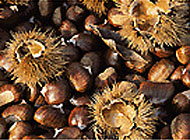
Chestnuts provide food for thought in Ascona

Dozens of scientists from more than 20 countries have gathered in the town of Ascona in southern Switzerland to discuss the results of a five year research programme into chestnuts.
Organisers of the conference insist that the importance of the chestnut tree and the edible fruit it bears should not be underestimated.
“Chestnuts are important throughout the whole Mediterranean,” said Ursula Heiniger of the Swiss Federal Research Institute WSL. “For some countries the nut is economically important as an export, while for others the tree is valued for its timber.
“It’s very durable and can be put to all sorts of uses outdoors as fences, window frames or avalanche barriers because the wood lasts for years without chemical treatment.
“Chestnuts are also resistant to forest fires because they can re-sprout from the roots and this gives them an advantage in areas with a high incidence of forest fires.”
The chestnut tree has not, however, proven resistant against the inroads of a fungus called chestnut blight.
When the disease arrived in Italy and spread to Ticino, experts feared the blight would wipe out chestnut trees in Europe as it did in the United States. By the 1950s the blight had destroyed the bulk of the one billion American Chestnut trees in the Appalachian Mountains.
Heiniger said that in Europe a large number of chestnut trees died off at first but by the mid-1950s the spread of the disease had slowed down. Researchers discovered that a hypovirus was attacking the malignant fungus, enabling the trees to recover.
This blight has been one of the areas of research at the Swiss Federal Research Institute WSL. “We’ve been looking for resistant varieties of trees and studying strains of the fungus and the hypovirus since the 1950s,” said Heiniger.
“There are different varieties of this hypovirus in Europe and it seems the Italian variety is the strongest and is most effective for biological control. It can be introduced into diseased trees by man,” says Heiniger, adding that this is especially important in areas where the hypovirus has not yet appeared naturally.
Another topic of research at the institute is the spread of the so-called ink disease, which attacks the roots of the trees. At the moment it appears to be limited to parts of Portugal, Spain and Southern Italy.
On the whole, however, despite these biological threats, Heiniger is upbeat about the future of the chestnut tree. It is not endangered anymore in Ticino, and trees are now being actively planted in orchards.
But she warned “because it’s a species imported by the Romans from Asia Minor, it needs the attention of man”.
It is no accident that the conference is taking place in canton Ticino. The chestnut is an important tree species in the region and before the arrival of the potato in the canton in the mid-1800s, chestnuts, with their high carbohydrate content, were a staple part of people’s diet.
The conference in Ascona, which continues until May 27, will also hear the results of research into genetics, insect pests, tissue culture, propagation and silvaculture.
The five-year programme was carried out with the support of the Brussels-based organisation COST, European Research Co-operation in Science and Technology.
by Paul Sufrin

In compliance with the JTI standards
More: SWI swissinfo.ch certified by the Journalism Trust Initiative




























You can find an overview of ongoing debates with our journalists here . Please join us!
If you want to start a conversation about a topic raised in this article or want to report factual errors, email us at english@swissinfo.ch.